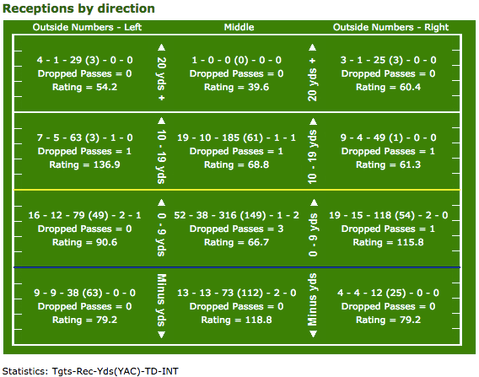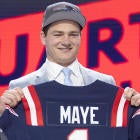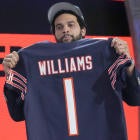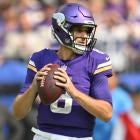Ryan Pace is cutting excess weight like it's his New Year's resolution.
After the Bears' season ended on Dec. 31 with a double-digit loss to the Vikings, wrapping up yet another playoff-less season, the general manager dedicated January and February to slimming down. First, he cut inside linebacker Jerrell Freeman, a star who couldn't stay on the field. Then, he declined to pick up All-Pro guard Josh Sitton's $8 million option for the 2018 season. Then, he released two defensive veterans in dominant, but never healthy pass rusher Pernell McPhee and safety Quintin Demps. Productive pass rusher Willie Young was the fourth causality of Pace's purge. Backup quarterback Mike Glennon will follow them onto the open market as soon as soon as the new league year begins. Lest we forget that Pace really got started by relieving coach John Fox of his post.
Pace's purge of older players to free up valuable cap space is meaningful, and not just because of the symbol of youth it provides (29-year-old Kyle Long, a first-round pick in 2013, is suddenly the oldest player on the team's roster). It's important because the Bears are now projected to own roughly $80 million in free cap space. Only two teams will have more, according to Spotrac. And contrary to the way most pundits view this team, the Bears really aren't that far off from becoming competitive. One stellar offseason could allow them to finally break the third-longest playoff drought in the NFL (2010). At worst, the Bears should be eyeing 2019 as their target.
Their quarterback, Mitchell Trubisky, already demonstrated in his rookie season that he's the franchise savior the Bears have been searching for since, well, forever. The Bears have a dominant pair of running backs in Jordan Howard (a pure hard-nosed runner) and Tarik Cohen (a Darren Sproles type). Even after losing Sitton, their offensive line projects to be a relative strength. Wide receiver is a glaring problem in that they have none. The defensive front is strong and the defense, as a whole, can be best described as blossoming under Vic Fangio's tutelage, though plenty of work on the personnel side still needs to be done.
More broadly speaking, with new head coach Matt Nagy running the kind of offense that turned Alex Smith into the league's highest-rated passer and Fangio returning to resume his work with the defense, there's belief that the Bears can become next season's version of the Rams -- a team that went 4-12 with a minus-170 point differential under Jeff Fisher in 2016 and 11-5 with a plus-149 point differential under Sean McVay in 2017. For as much credit as McVay received for the turnaround, the front office deserves just as much credit for the offseason roster overhaul.
Predicting the Bears to become the Rams seems far-fetched. It's not every year a team undergoes a historic turnaround the way the Rams did in 2017. For all of their roster improvements, the Bears came away with only five wins in 2017. Expecting them to win 11 games is placing unfair expectations on Nagy.
That being said, the Bears really do look like a team that is close to making the jump to hyperspace, if not this year than next. With that in mind, let's examine the eight personnel moves that Pace should make to end the Bears' playoff drought. Obviously, Pace's offseason checklist will extend beyond just eight items -- he'll need to bolster the pass-rush and other holes with smaller, high-upside signings -- but these are the major moves that should be near the top of his list.
Prologue: What's the problem?
First, we need to address the Bears' issues, all of which I believe they can begin to address this offseason. The Bears went 5-11 and got outscored by 56 points over the course of the season. Problems exist.
Their biggest issue is receiver. A year ago, after losing Cameron Meredith to a torn ACL in the preseason, Kendall Wright led the team with 59 receptions and 614 receiving yards. They need a new guard with Sitton leaving and maybe a new right tackle with Bobby Massie often being the weakest link of the offensive line. Cutting McPhee and Young freed up money, but suddenly the Bears are without two pass rushers who combined for 40 sacks in their Chicago careers. The secondary remains shaky. Kicking -- yes, we're talking about kickers -- has been a nightmare ever since they foolishly cut Robbie Gould. Over the past two seasons, the Bears' collection of kickers have gone 34 of 45 on field goals (75.6 percent).
Those are the areas the Bears need to improve. Here's how they can do exactly that.
1. Don't trade for Jarvis Landry
Before the Miami Dolphins made the somewhat surprising decision to franchise tag Jarvis Landry, the Bears were listed as a contender to sign the shifty pass-catcher. In the aftermath of the Dolphins' decision, the Bears were reported to be interested in trading for Landry. One rumor, which was later shot down, even listed a specific offer that had been discussed, which involved the Bears sending star running back Jordan Howard and the eighth-overall pick to Miami for Landry, the 11th-overall pick, and a third-round pick.
It's a horrible idea. The answer to the Bears' problems at receiver is not Landry, who is really best described as a "pass catcher" instead of a "wide receiver." Landry is very good at what he does, which is catching passes. He's averaged 100 catches per season since he entered the league. It's just that, what Landry does is not that valuable to a football team. In Landry's career, he's averaged 10.1 yards per catch. In 2017, his average dropped to 8.8 yards per reception. To put it another way, Landry led the league in catches this past season with 112 but he ranked 17th in receiving yards -- one spot ahead of Colts receiver T.Y. Hilton, who ranked 52nd (tied) in receptions.
The point being, Landry catches passes but doesn't gain yards. What's the point of catching passes if you don't gain yards? You win football games by scoring points, which comes as a result of gaining yards en route to the end zone. Giving a player credit for a high reception total is like giving credit to a running back for racking up a ton of carries even though he's averaging 3.0 yards per carry. Now, imagine a team wanting to pay that player like he's one of the best players at his position group.
That doesn't mean that Landry can't be valuable to a team. But Landry will not be valuable to the Bears at what it'll cost to trade for him and then sign him to a long-term contract. The Bears shouldn't be spending their money on an overpriced safety valve. The Bears don't need a receiver who is incapable of stretching the field. They need someone who operates in areas other than behind the line of scrimmage and within the first 10 yards downfield.

Something Trubisky is already good at? Throwing deep. Even though he was throwing to a no-name cast of receivers, he posted the third-highest passer rating (108.1) on throws that traveled at least 20 yards downfield, according to PFF. Imagine what he can do if the Bears get him some help.
2. Go after Allen Robinson or Sammy Watkins
Which brings us to the big-name receivers the Bears should be targeting.
First up is Allen Robinson, who should be Pace's primary target. Not only is Robinson young (still only 24), but he's really good. In 2015, Robinson showcased his talent by hauling in 80 passes for 1,400 yards (17.5 yards per catch) and 14 touchdowns. His numbers dipped in 2016, when he caught 73 passes for 883 yards (12.1 yards per catch) and six touchdowns, but keep in mind that he's been catching passes from Blake Bortles his entire career. The only reason Robinson is hitting free agency is because he tore his ACL on his first reception of the 2017 season. Most assumed he'd be franchise tagged by the Jaguars. But Tuesday's deadline came and went without his name getting mentioned. He's free to leave.
The Bears need to make Robinson a priority. With a torn ACL and only one elite season on his resume, Robinson comes with some risk. But the Bears should be targeting young players with upside. That's what Robinson is. And he'd instantly become their best receiver. Most importantly, the Bears aren't strapped for cash right now. So they can, in theory, make him a more enticing offer than other receiver-needy teams.
If the Bears miss on Robinson -- let's face it, they'll have plenty of competition -- they should turn their attention to Sammy Watkins, who likely won't get as much money as Robinson in part because of his injury history and inconsistent history of producing. But, like Robinson, Watkins is young (24) and holds plenty of upside. Consider this: He's averaging 15.9 yards per catch in his career and more than six touchdowns per season. He's the deep threat the Bears desperately need.
The Bears need a WR1 this offseason. Strangely, two young WR1s are hitting the open market. They can't let both slip through their grasps.
A cheap option if they miss on both players could be Paul Richardson, who checks in at No. 21 on Pete Prisco's list of free agents.
3. Sign Albert Wilson
Regardless if they land either of those two top playmakers, the Bears should make a lower-profile signing to bolster their receiving corps. Albert Wilson is the WR3 that should be on the Bears' radar. Wilson comes from Kansas City, where he got outshined by Tyreek Hill and Travis Kelce. He's a solid pass-catcher who is capable of filling the role Landry would've taken. In a 13-game 2017 season, he caught 42 passes for 554 yards and three touchdowns.
Like Landry, Wilson does most of his work behind and close to the line of scrimmage. Unlike Landry, he'll be relatively cheap to sign.

At this point, it seems like near certainty that Wilson will land in Chicago. Nagy comes from Kansas City, Wilson and Nagy are no doubt familiar with each other. Even Chiefs GM Brett Veach seems to think it'll happen.
Will WR Albert Wilson leave the #Chiefs? KC GM Brett Veach: ‘Well, Matt’s in Chicago.’
— Patrick Finley (@patrickfinley) March 1, 2018
4. Bring back Inman
The Bears can't stop there, which really goes to show how dire their current receiver situation is. But to fill out their rotation after signing a WR1 and Wilson, the Bears should look to bring back Dontrelle Inman, who arrived in Chicago after a midseason trade with the Chargers.
Inman's stats with the Bears won't jump off the page -- in eight games, he caught 23 passes for 334 yards and one touchdown -- but those who watched the entire Bears season will testify that he immediately added a dimension to their offense that they lacked. Inman isn't a WR1, but he's a starting-caliber NFL receiver, evidenced by his 810-yard season in 2016. It's no coincidence that Trubisky's quality of play improved after Inman arrived. After trading for him, the Bears shouldn't just let him go for free. He still has a role to play. It's worth noting that if the Bears do not land any of the above listed targets, they should make re-signing Inman a priority.
But if the Bears do sign Robinson/Watkins, Wilson, and Inman, they should fill out their receiving squadron by hoping Cameron Meredith can recover from his torn ACL, which he suffered in August. In 2016, Meredith broke out with 888 yards and four touchdowns. He's a restricted free agent. Then, they'll let former first-round pick Kevin White, who has appeared in five games in three seasons, compete for a roster spot. That's how I'd fix the receiver problem.
5. With the eighth-overall pick ...
If the Bears can fix their receiver problem in free agency, it creates a ton of exciting possibilities in the draft. Holding the eighth-overall pick, the Bears don't want to be caught in a position where they have to reach for a receiver that high because there probably isn't a prospect in this draft who's worth the eighth pick. That's why targeting receiver in free agency is so important.
Assuming the Bears can fix the receiver situation in free agency, they should be targeting the best player available at No. 8. Two players come to mind. The first is Notre Dame guard Quenton Nelson, who is projected to go somewhere in the top 10. Here's where it's worth noting that the Bears' new offensive line coach, Harry Hiestand, is coming off a six-year run at ... Notre Dame. Nelson would be the perfect replacement for Sitton. And the Bears should continue to prioritize the offensive line. According to PFF, Trubisky posted a 48.7 passer rating under pressure.
If Nelson isn't there, the Bears should look at inside linebacker to replace Freeman. Virginia Tech's Tremaine Edmunds blew teams away at the combine while Georgia's Roquan Smith has been regarded as the top prospect at the position. Either would start immediately alongside Danny Trevathan and plug a spot vacated by Freeman. Another need is cornerback. Joshua Jackson or Denzel Ward could make sense there.
The bottom line is that targeting receivers in free agency provides the Bears with so much more freedom in the draft to fix other areas.
6. Keep Kyle Fuller and Bryce Callahan
Two free agents the Bears need to bring back are a pair of cornerbacks in Kyle Fuller and Bryce Callahan. Fuller, a former first-round pick, rejuvenated his career in 2017, racking up two picks and 22 passes defended, and accumulating a 69.0 passer rating in coverage, which ranked 17th among qualified cornerbacks, according to PFF. He was fantastic downfield.
Kyle Fuller on deep throws 😳 pic.twitter.com/NZw2zC3tfH
— Pro Football Focus (@PFF) March 4, 2018
Callahan, meanwhile, served as the Bears' slot cornerback and he excelled in that role, notching two picks. More advanced statistics paint a more accurate picture of his production.
Bryce Callahan's slot coverage statistics in 2017 👀 pic.twitter.com/LT1O0JArhM
— Pro Football Focus (@PFF) February 21, 2018
The Bears want Fuller back. Before Tuesday's deadline, they transition tagged him, which gives them the right to match any offer he might get on the open market. Given just how much cap space the Bears own, they should be able to match an offer or come to terms on a long-term agreement with him. Letting him play on the tag also wouldn't be a bad outcome given his inconsistencies throughout his career.
As for Callahan, he's a restricted free agent. The most likely scenario sees the Bears doing everything in their power to hang onto him while letting their other free agent cornerback, Prince Amukamara, leave. They'd be foolish to let Callahan walk. He's developed into one of the better slot receivers in football, and the Bears are in need of good cornerbacks.
7. Find their next Robbie Gould
This one isn't simple. For as much as we tend to minimize the importance of kickers, it can be hard to find a reliable one. The Bears know this all too well. After cutting Gould on the eve of the 2016 season -- a very stupid decision in hindsight, which was punctuated by his revenge game in December -- the Bears have been consistently let down by their Connor Barth, Mike Nugent, and Cairo Santos group. They need to find a more-reliable replacement from Gould, the franchise's all-time leading scorer.
Some intriguing options exist on the open market, from Sebastian Janikowski to Cody Parkey, but they won't find an easy solution. Still, the Bears can't keep making field goals at a rate of 75.6 percent.
8. Hit on low-cost options
Ryan Pace has a history of nailing some under-the-radar signings from Akiem Hicks, who has developed into arguably the Bears' best defensive player, to the drafting of Tarik Cohen and Adam Shaheen. For the Bears to get back to relevance, they'll need Pace to hit on more cheap options this offseason. Below, I've listed a few players I view as solid value pickups in the sense that they'll be cheap(-ish) and feature some upside:
- Pass rusher Dion Jordan, who looked solid in Seattle in 2017. The Bears have a need after cutting McPhee and Young.
- Linebacker Avery Williamson, who ranks 22nd on Prisco's free agent list. Freeman was stellar against the run and that's Williamson's strength, which makes him a suitable replacement. He's only 25.
- Pass rusher Kony Ealy, who you probably remember from the Panthers' loss to the Broncos in Super Bowl 50.
These are the moves that are too hard to predict and will largely be determined by what happens with the bigger name free agents. As is the case with mock drafts, predicting how free agency will proceed is more of a thought exercise than an actual projection.
Only Pace knows how he wants to handle the next few months. Based on what happened last year, don't be surprised if he does something unconventional.






















